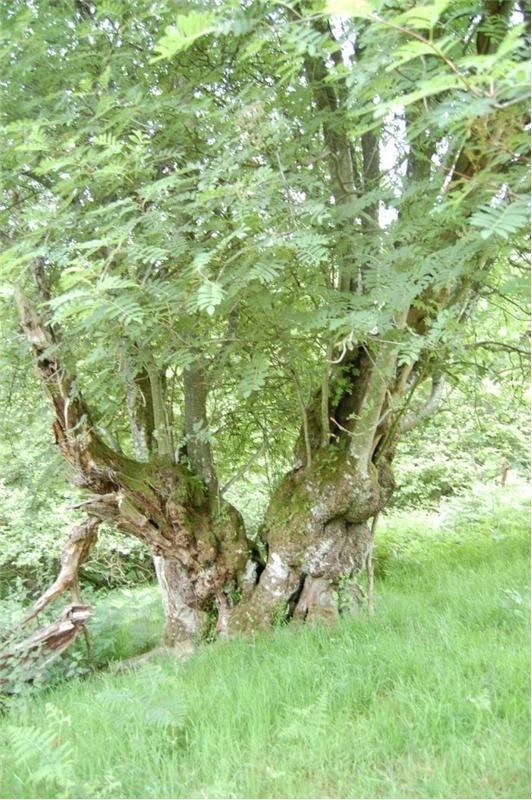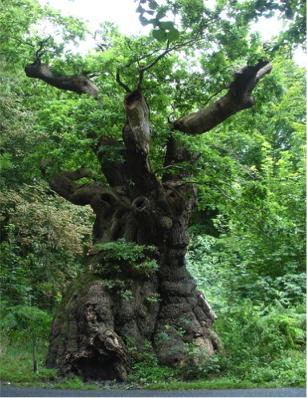Predicting the distribution of ancient and veteran trees across the UK.
Introduction and aims of the project overall
The aim Victoria’s research project was to use the ATI to learn more about the true distribution of ancient and veteran trees across the UK and to gain insight into what environmental and human factors are most significant for describing their distribution. By highlighting areas that are likely to be suitable for ancient trees, Victoria’s research will help to target future ancient tree recording / surveys, which will help to make recording and mapping ancient trees to the ATI more efficient. The overall aim of the project was to produce a more accurate distribution map that highlights key areas ‘hotspots’ that might be more likely to support unrecorded ancient trees.

Avenue of ancient sweet chestnut trees at Croft Castle. (Photo: Archie Miles)

Llangernyw yew in Conwy, Wales. (Photo: Rory Francis/WTML)
The project was divided into three key phases.
Phase 1: ATI data analysis
- Investigating key trends in the ATI data, including understanding the current distribution of records, the recording process and potential gaps in recording, as well as 'sampling bias' (where some areas have experienced more recording than others). The findings of this analysis are published here
Phase 2: Modelling Ancient and Veteran Tree distributions
- Creating models of ancient and veteran tree distributions across the UK based on the ATI, environmental variables and other characteristics.
- Applying different sampling bias correction methods to the models and the ATI to test for and remove errors and biases in the data.
Phase 3: Field verification of the model
- Random, unbiased, independent field surveys were carried out to collect more data to evaluate the models and choose the best distribution map.
- Creating predictions of ancient/veteran tree hotspots and an estimate of the total number of ancient and veteran trees across England

An ancient rowan tree.

Two pollarded ancient hornbeams, Hatfield Forest.
Habitat scale: predicting locations of undiscovered ancient trees in wood-pastures across England
Introduction: Wood-pastures, royal forests and historic parklands are habitats which often contain an abundance of ancient trees. There may be many partially or completely un-surveyed wood-pastures that contain as-yet-unrecorded ancient trees. The ATI data enabled Victoria to investigate which factors determine ancient tree abundance in wood-pastures, with the aim of identifying sites likely to contain undiscovered ancient trees across England.
Methods: Victoria used a variety of different information about the environment, topography and human factors about each wood-pasture as inputs for the model. These factors, alongside the knowledge of any already-recorded ATI records in each wood-pasture, allowed Victoria to predict the likelihood of the presence of unrecorded ancient trees on un-surveyed wood pastures. To verify the accuracy of the model’s predictions, a series of historical Ordnance Survey (OS) maps, showing the location of individual trees, were used together with a modern tree map for England to estimate ancient tree abundance for a randomly selected sample of wood-pastures.
Results: The analysis found that wood pastures are more likely to contain ancient trees if they were:
- larger in area
- far from a city
- close to a historic medieval deer park or common
- on land owned by the National Trust
- in a broadleaved habitat
Factors which made it less likely for a wood pasture to contain ancient trees included presence/proximity to roads and certain soils types which limit root growth.
Conclusion: Based on this modelling, the most conservative estimate of ancient tree abundance in English wood-pastures was 101,402 trees, representing a 2112 % increase on the known number of ancient trees in wood-pastures. This prediction highlights the fact that most ancient trees in the English landscape are yet to be recorded. These findings highlight the need for more targeted surveys of wood-pastures with high predicted suitability for ancient trees to assist with the conservation and protection of valuable UK ancient trees and wood-pasture habitats.

Big Belly oak, Savernake Forest. One of the UK's most iconic oak trees, growing on the edge of a former royal hunting forest.

A large sncient sweet chestnut tree growing on the edge of a wood pasture habitat.
The wider picture: identifying keys areas for ancient and veteran trees across the whole of England
Introduction: The first part of Vicky’s research highlighted that there was evidence of recording bias in the ATI i.e. some regions appear to have had a greater level of recording activity than others. This can happen for a number of reasons, such as accessibility to trees, the recording of trees in areas that are nicer to survey, increased activity from active local groups or ‘super-recorders’, as well as recorders targeting areas where there are likely to be more ancient/veteran trees present. Therefore, the current map of ancient and veteran trees across the UK may be more representative of survey effort rather than the true tree distribution. This part of Victoria’s research aimed to create more accurate maps of ancient and veteran tree distributions.
Methods: Victoria split the area of England into 1-km x 1-km squares and use distribution models to create predictions of the number of ancient and veteran trees per square. In addition, model predictions were ground-truthed by carrying out nationwide, surveys of a random sample of the 1-km grid squares.
Results: Across the 52 ground-truthed squares, a total of 459 ancient and veteran trees were recorded; 285 of which had not been previously recorded on the ATI. Before the surveys only 15 out of 52 squares had records of ancient or veteran trees, but this number was increased to 38 out of 52 following the surveys. Maps of predicted ancient and veteran tree distributions using the current (biased) ATI records showed that the majority of areas predicted to have lots of trees are mostly large wood-pastures, forests and parks, especially around London, the Lake District and Herefordshire. However, maps from the best model which has been corrected for sampling bias show a lot more variation across England, and suggests there are many more areas with high suitability for the trees, including Suffolk, Northumberland, Devon and areas around London (Figure 1).
Conclusion: Estimates of the total number of ancient and veteran trees suggest there might be 2 million ancient and veteran trees across the whole of England. From these surveys alone, we have seen clear large gaps in our knowledge of the current distributions of these trees, with consequences for their lack of protection and ecological monitoring and management. Our research therefore provides strong support for the need to find and record these trees. There is sampling bias in the ATI, but by using correction methods, distribution models and independent field surveys, robust maps of ancient and veteran trees can be produced to aid conservation.

Figure 1. Left: the current ATI distribution and right: the best model of predicted habitat suitability for ancient and veteran trees based on the field work after applying sampling bias correction. Habitat suitability ranges from low (blue) to high (red).
Overall conclusion of the project
Victoria’s research on the ATI presents the first empirical studies of ancient and veteran trees across the UK, and provides an overview of the current records and potential true distribution of trees. It shows that wood-pastures are a key habitat for ancient trees, within which there are many more to be discovered. It also provides insight into the variety of environmental, anthropogenic and topographical factors that influence the probability of finding ancient trees at a particular wood-pasture site. Expanding the modelling process to the whole of England, and correcting for sampling bias in the ATI, provided new insight into areas likely to contain ancient and veteran trees, many of which are not thought to be ‘hot-spots’. Estimates of the total number of ancient and veteran trees in England reached an amazing 2 million trees. All of these findings can help to find and record undiscovered ancient and veteran trees across the UK and to help ensure their survival and protection in the future.
Links
Please us the links below to access the scientific publications where Victoria's work can be found:
The Ancient Tree Inventory: a summary of the results of a 15 year citizen science project recording ancient, veteran and notable trees across the UK
Historical maps confirm the accuracy of zero-inflated model predictions of ancient tree abundance in English wood-pastures
Distribution models calibrated with independent field data predict two million ancient and veteran trees in England
